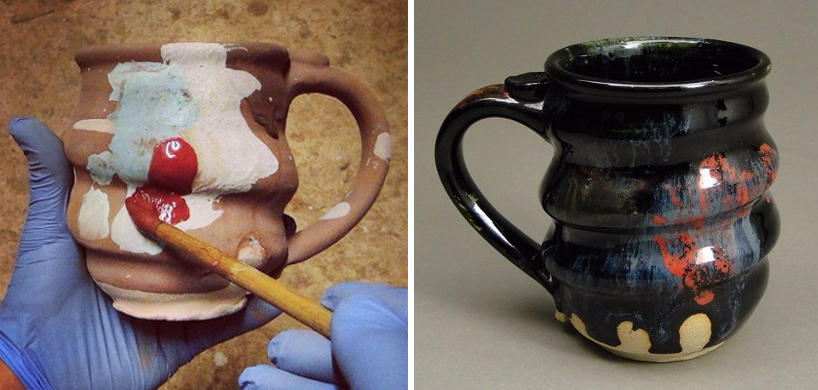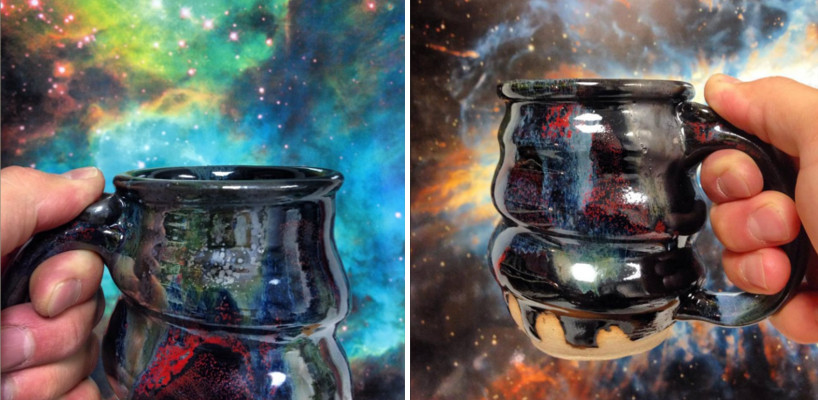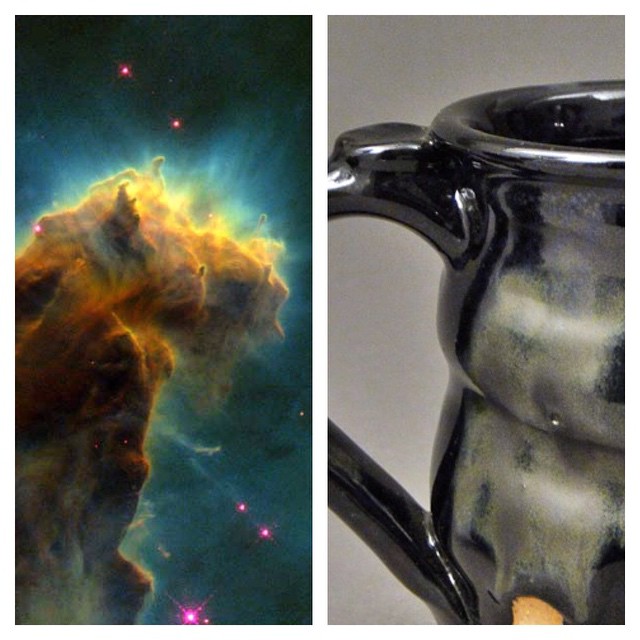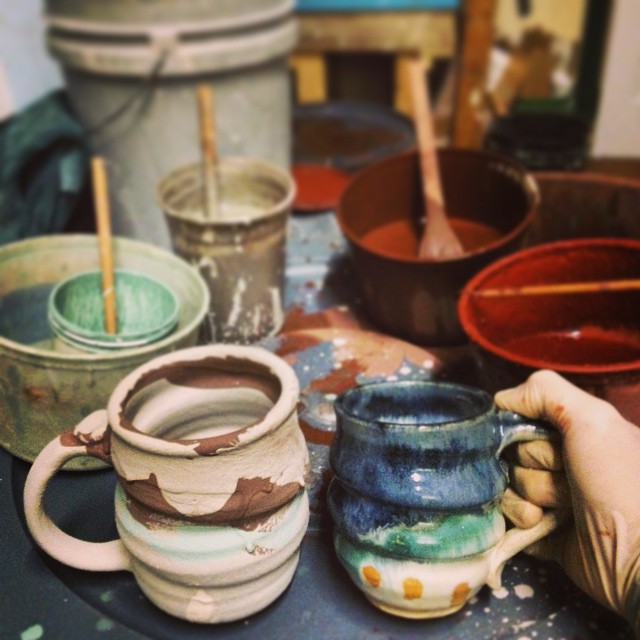Special thanks to Ceramics TECHNICAL magazine for publishing an awesome pottery article written by author Marissa Deml! Marissa and I worked together last year and came up with the idea to create “Cosmic Mugs.” As a Marketing Intern, her final project was to write and submit an article to a professional publication. Thanks to her skills as an author, our work got published! You can read her four page article below, and also purchase a hard copy of Ceramics TECHNICAL here.
YouTube Video, Cosmic Mugs: Pottery Inspired by NASA’s Hubble Space Telescope
These “Cosmic Mugs” are largely inspired by Dr. Neil deGrasse Tyson, astrophysicist and director of the Hayden Planetarium in New York City (in the video, he’s the guy on my shirt). In his article titled, “The Universe As A Muse” Dr. Tyson said:
“Like the religious and mythological sources that so influenced art before and during the Renaissance, countless artists today are moved by the need to capture the cosmos—on film, in dance, and on canvas.”
Here is a video I made about how the cosmos influences my pottery. Enjoy!
Cosmic Mugs: Pottery Inspired by NASA’s Hubble Space Telescope
Cosmic Mugs: Pottery Inspired by NASA’s Hubble Space Telescope
After creating my newest body of artwork, “Cosmic Mugs” with glazes inspired by images from NASA’s Hubble Space Telescope, I find myself asking, “Why?” Why try to show huge galaxies and nebulae on a small mug? I turned to mainstream science advocate Dr. Neil deGrasse Tyson for guidance. During the Origins Project at Arizona State University, Dr. Tyson critiqued an iconic painting by Vincent van Gogh: The Starry Night.
“I want and I need the artist to take me to new places, and the new place van Gogh took me is not the sky as it is, but the sky as he felt it. And the more of us that feel the universe, the better off we will be in this world.”


Unlike a painting or sculpture, pottery mugs are meant to be touched, picked up and brought to the mouth and nose. How many other types of artwork do you actually touch with such intimate parts of your body? I want my “Cosmic Mugs” to communicate beauty like a van Gogh painting, while deeply engaging multiple senses. Why does art that hangs on a wall deserve more value than art that holds coffee or tea? I make these “Cosmic Mugs” to challenge that notion by letting people experience fine art in daily life.
How many brush strokes are in a van Gogh painting? Thousands and thousands! How do my simple coffee mugs relate when they have only a few brush strokes?

Complexity is revealed in the kiln firing. Raw earth metals like iron, copper and cobalt are mixed with water and brushed onto the pot. Massive energy is needed to fire each pot to 2400 degrees F, melting glaze chemicals together into a hard, glassy surface. I give up control, letting the kiln melt glazes into an abstract painting that I can never fully predict.

Will my glazes ever compare to the complexity of a Hubble image? This photo of the Andromeda galaxy has 1.5 billion pixels and you would need 600 HD TV screens to see the true photo!
Looking closely at each pottery mug gives us a deeper understand of how Hubble images manifest as abstract glaze paintings. It shouldn’t look identical, but it should feel similar.



Cosmic Mugs are…
- Durable: Stoneware pottery is very hard and meant to last a lifetime.
- Functional: 100% non-toxic and dishwasher safe.
- Handcrafted: I make each pot from a lump of Stoneware clay on a pottery wheel.
- Complex: Every mug is brushed with up to 5 different glaze colors.
- Earthen: Raw iron, copper and cobalt are harvested from the earth & fired in a kiln to 2400 degrees F to seal colors with silica glaze for non-toxic, food-safe surfaces.
- On of a Kind: Each firing results in glazes that I can never duplicate exactly.

We can look closely with detail shots, extreme zooms, and even a microscope to get a better understanding of the subtle textures that can’t be seen with the naked eye.



Even simply enjoying a cup of coffee outdoors in bright sunlight can reveal new subtleties.


Hubble images are free for anyone to use in the public domain, as long as proper credit is given. I sent a mug to the Space Telescope Science Institute as a thanks for freely providing such beautiful images, and hopefully to build bridges between art & science. 
Stay tuned for just a few new jewels popping up in my online store in the coming months!
Thanks for reading! Check out my Instagram to stay updated with my newest pottery:
Cosmic Mugs, Cups and Vases in the Online Store
This holiday season, I’m excited to share a new style of pottery with you. My electric fired “Cosmic Mugs” are inspired by images of NASA’s Hubble Space Telescope from www.hubblesite.org. Real images of deep space galaxy cloud and nebula inspire my abstract glaze paintings over an “Oil Spot Black” base glaze, meant to reference the night sky. My stoneware coffee mugs are 100% functional, microwaveable and dishwasher safe, and available in my online store:

The online store is also filled with a variety of pottery in my Nuka glaze, made with ashes from the St. John’s Arboretum in Collegeville, MN. I’m selling pots as low as $10 each, and these pieces are colored with cobalt blue, copper green and gold iron drips:
Cosmic Pots: The “Goldilocks Glaze”
Thirty-four years ago, astronomer and Cosmos host Carl Sagan made his famous claim:
“If you wish to make an apple pie from scratch, you must first invent the universe.” – Carl Sagan. “The Lives of the Stars.” Cosmos: A Personal Voyage. PBS. 1980.
Sagan could have been talking about making anything from scratch. His goal was to convey that everything on earth, everything in the universe, is made up of precise combinations of the most basic elements, and those elements were created in stars’ nuclear cores. We could also say, “If you wish to make a pot from scratch, you must first invent the universe.”
These star-forged elements combine to form all the components of ceramics: the different strains of clay (silicon and iron), the water used in throwing (oxygen and hydrogen), the arboreal ingredients of glazes (calcium), and even the potter himself (carbon). Entire books could be written focusing solely on one of these ceramic elements.
 Copper, for example. Copper red glazes have been meticulously pursued and produced since the fifteenth century in China. The new host of Cosmos, Neil deGrasse Tyson, often analyzes the concept of a “Goldilocks planet” – a planet which has the precise conditions for possibly sustaining life. A successful copper red glaze is a “Goldilocks glaze.” Everything in both the recipe and the firing must be perfect.
Copper, for example. Copper red glazes have been meticulously pursued and produced since the fifteenth century in China. The new host of Cosmos, Neil deGrasse Tyson, often analyzes the concept of a “Goldilocks planet” – a planet which has the precise conditions for possibly sustaining life. A successful copper red glaze is a “Goldilocks glaze.” Everything in both the recipe and the firing must be perfect.

As Sagan and Tyson have taught us, science is found in everything we do. Baking an apple pie from scratch, developing a new drug, and mixing and firing glazes all rely on experimentation, creativity, and chemical reactions. A potter doesn’t need a degree in chemistry, but he uses some pretty cool science to produce copper red glazes.
 Nowadays, gas-fired kilns produce the best conditions for copper red glazes, but ancient Chinese potters created their beautiful pieces using only wood-fired kilns. Many potters do not have regular access to gas- or wood-fired kilns, and use electric ones instead. Electric kilns eliminate the need for constant temperature monitoring, but they are unable to create the atmosphere copper red glazes require.
Nowadays, gas-fired kilns produce the best conditions for copper red glazes, but ancient Chinese potters created their beautiful pieces using only wood-fired kilns. Many potters do not have regular access to gas- or wood-fired kilns, and use electric ones instead. Electric kilns eliminate the need for constant temperature monitoring, but they are unable to create the atmosphere copper red glazes require.

Copper red glazes need to be fired to a temperature called “cone 10.” This photo shows three cones (small pieces of clay), set up inside a gas-fired kiln. Each of these pieces is made from a different factory-produced type of clay formulated to melt at a certain temperature. A device called a pyrometer can be used to measure the temperature of the air inside the kiln, but what really matters is the temperature of the clay, hence the use of cones. When cone 10 melts, the potter knows the clay is roughly 2345 °F.
 Even inside the same kiln, the atmosphere unavoidably varies. The pots below all had the same glaze and firing, but were placed in different areas of the kiln.
Even inside the same kiln, the atmosphere unavoidably varies. The pots below all had the same glaze and firing, but were placed in different areas of the kiln.
 The green color on the right also occurs when firing a copper glaze in an electric kiln.
The green color on the right also occurs when firing a copper glaze in an electric kiln.
Color, just like copper, depends on the stars. Light from our sun strikes objects on earth, and those objects absorb some wavelengths of light and reflect others. The wavelengths they reflect are the colors we see. As Tyson puts it:
“Color is the way our eyes perceive how energetic light waves are.” – Neil Degrasse Tyson. “Hiding in the Light.” Cosmos: A Spacetime Odyssey. Fox. 2014.
Thankfully, potters did not have to create the universe to make pots from scratch. Their ingredients are already present in the cosmos, swirling in the air and lurking in the earth, waiting for them.
















